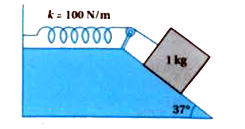Two identical piano wires kept under the same tension T have a fundamental frequency of 600 Hz. The fractional increase in the tension of one of the wires which will lead to occurrence of 6 beats/s when both the wires oscillate together would be ......Solution in Gujrati
0.02
0.03
0.04
0.01
The correct Answer is:A
We have f=12L√Tμ⇒f∝√T⇒f=K√T
(Where K = constant of proporationaly)
∴dfdT=K12√T=f√T×12√T=f2T
∴dTT=2(dff)=2×6600=0.02
⇒ Fractional increases in tension =0.02
Topper's Solved these Questions
- WAVESBook:KUMAR PRAKASHANChapter:WAVESExercise:SECTION-F (Questions From Module) (Sample questions for preparation of competitive exams)
Explore 23 Videos
- WAVESBook:KUMAR PRAKASHANChapter:WAVESExercise:SECTION-D (NCERT Exemplar Solution) (Long Answer Type Questions)
Explore 5 Videos
- UNITS AND MEASUREMENTBook:KUMAR PRAKASHANChapter:UNITS AND MEASUREMENTExercise:Section -F (Questions from Module )
Explore 20 Videos
- WORK, ENERGY AND POWER Book:KUMAR PRAKASHANChapter:WORK, ENERGY AND POWER Exercise:QUESTION PAPER (SECTION - D)
Explore 1 Video
Similar Questions
In a standing wave formed by two atoms separated by 1.21Å, there are 3 nodes and 2 antinodes. Find its wavelength.
View SolutionThe earth has a radius of 6400 km. The inner core of 1000 km radius is solid. Outside it, there is a region from 1000 km to a radius of 3500 km which is in molten state. Then again from 3500 km to 6400 km the earth is solid. Only longitudinal (P) waves can travel inside a liquid. Assume that the P wave has a speed of 8 kms−1 in solid parts and of 5kms−1 in liquid parts of the earth. An earthquake occurs at some place close to the surface of the earth. Calculate the time after which it will be recorded in a seismometer at a diametrically opposite point on the earth if wave travels along diameter ?
View SolutionIf the error in measurement of radius of a shpere is 2% then the error in determination of volume of the sphere will be …………
View SolutionA 1 kg block situated on a rough incline is connected to a spring constant 100Nm−1 as shown in figure . The block is released from rest with the spring in the unstretched position . The block moves 10 cm down the incline before coming to rest . Find the coefficient of friction between the block and the incline .Assume that the spring has a negligible mass and the pulley is frictionless.

View SolutionA piano wire A vibrates at a fundamental frequency of 600 Hz. A second identical wire B produces 6 beats per second with it when the tension in A is slightly increased. Find the ratio of the tension in A to the tension in B.
View SolutionTwo identical sonometer wires have a fundamental frequency of 500 Hz when kept under the same tension . The percentage change in tension of one of the wires that would cause an occurrence of 5 beats//s , when both wires vibrate together is
View SolutionThe identical piano wires kept under the same tension T have a fundamental frequency of 600 Hz. The fractional increase in the tension of one of the wires which will lead to occurrence of 6 beats//s when both the wires oscillate together would be
View SolutionTwo identical piano wires have fundemental frequency of 600vib/sec, when kept under the same tension. What frectional increase in the tension of one wire will lead to the occurrence of six beats per second when both wires vibrate simuitaneously.
View SolutionTwo identical wires have the same fundamental frequency of 400 Hz . when kept under the same tension. If the tension in one wire is increased by 2% the number of beats produced will be
View SolutionTwo identical wires have a fundamental frequency of 100Hz, when kept under the same tension . If the tension of one of the wires is increased by 21% , the number of beats produced is
View SolutionTwo identical piano wires have a fundamental frequency of 600 cycle per second when kept under the same tension. What fractional increase in the tension of one wire will lead to the occurrence of 6 beats per second when both wires vibrate simultaneously?
View SolutionThe identical piano wires kept under the same tension T have a fundamental frequency of 600 Hz. The fractional increase in the tension of one of the wires which will lead to occurrence of 6 beats//s when both the wires oscillate together would be
View SolutionTwo identical piano wires have a fundamental frequency of 600 Hz when kept under the same tension. What fractional increase in the tension of one wire will lead to the occurrence of 8.0 beats/s when both wires oscillate simultaneously?
View SolutionTwo identical sonometer wires have a fundamental frequency of 500 Hz when kept under the same tension. What fractional increase in the tension of one wire would cause an occurrence of 5 beats per sec, when both wires vibrate together?
View SolutionTwo identical sonometer wires have a fundamental frequency of 500 Hz when kept under the same tension. What fractional increase in the tension of one wire would cause an occurrence of 5 beats per sec, when both wires vibrate together
View Solution

